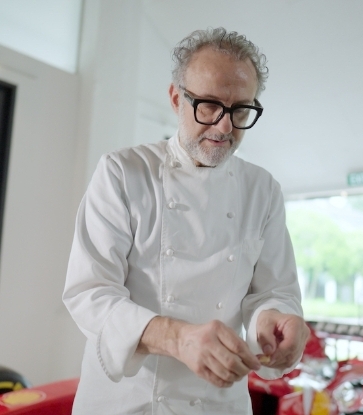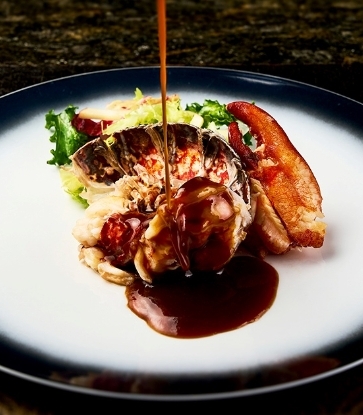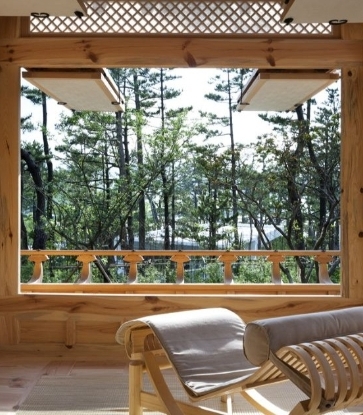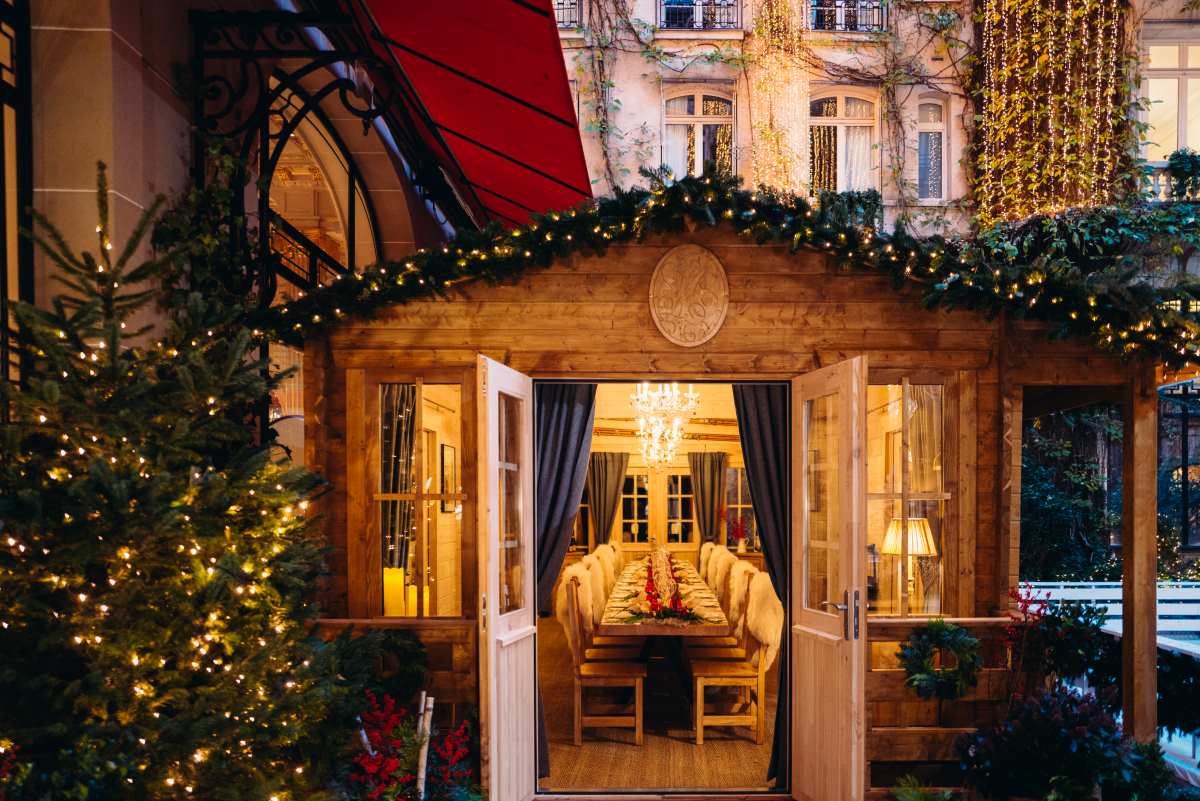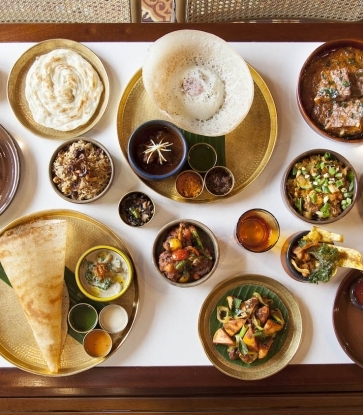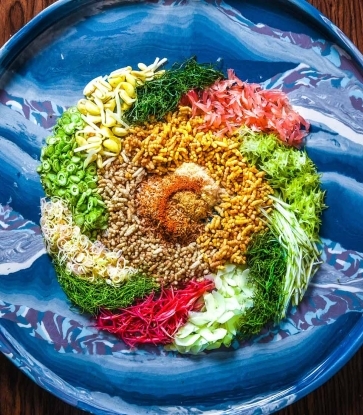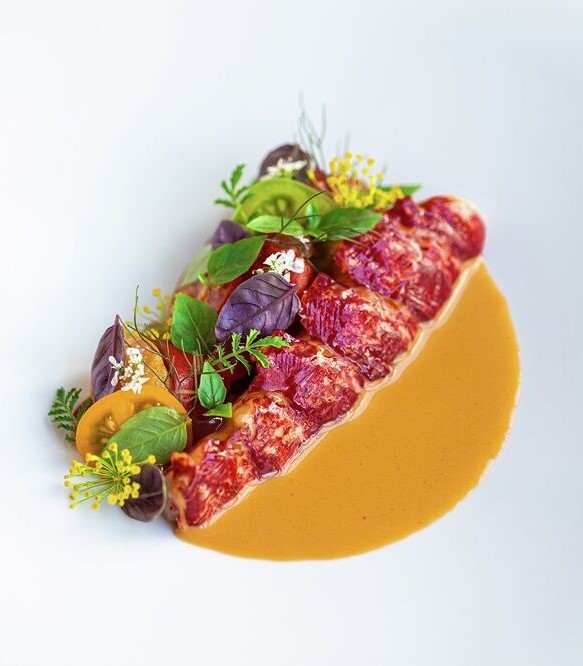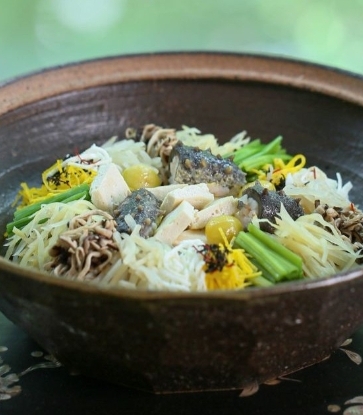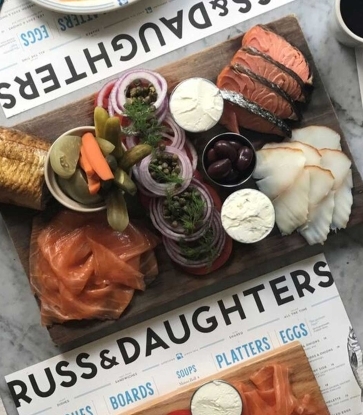A youthful 27 years old. That was the age when Dai Hayashi of hakunei became a chef at a One MICHELIN Star restaurant. ‘We aimed to get One MICHELIN Star since our opening last year, and we achieved it as a team, so I am incredibly happy.’ This happened just over a year after the restaurant first opened.
He was born in Kyoto in 1997 and raised in Saitama. Thanks to the influence of his mother, herself a skilled cook, his childhood dream was not just to become a chef, but to become a chef at a MICHELIN starred restaurant. He attended a cooking school in Saitama, and was impressed upon first tasting French duck, foie gras, and lobster, being surprised to find that such delicious food existed in the world. That was the moment he decided on his path – to become a star chef of French cuisine. After graduating he worked at a French restaurant near his family’s home for three years and then spent another three years at Margotto e Baciare in Tokyo. Then, as he was searching for a new path, owner Ryoji Hayashi reached out and entrusted him with hakunei.
The name ‘hakunei’ means ‘facing food with pure feelings and care.’ It comes from Dai Hayashi himself. The Japanese character for “nei,” composed of the elements for roof, signifying a house, as well as heart and plate, shows the desire to create a home-like space where guests can feel at ease enjoying cuisine. It also signifies the French word ‘restaurer’ (rest, restore, regain energy), derived from it being a French restaurant.
DISCOVER MORE: Tokyo by The MICHELIN Guide

Discovering the best solutions in modern cuisine
When customers ask what kind of food he serves, he answers French cuisine. However, he thinks of his food as modern-style cuisine based on techniques he learned through French cuisine. What is modern-style cuisine? It’s the ideal cuisine for modern Japanese people and the modern world. He thinks of modern-style cuisine as a dish that aligns with the dynamic, diverse culinary landscape of Tokyo, a city teeming with international flavours. Tokyo is also a place where one can find carefully selected ingredients from all across Japan. Techniques from around the world can be applied to highlight the unique qualities of these ingredients, bringing out their best. This idea comes from the approach of Kenta Kayama, the chef at Margotto e Baciare, as well as his mentor Hiroyuki Kanda, of the Three MICHELIN Star restaurant Kanda. They adjust the techniques flexibly, according to the unique qualities of the ingredients and the characteristics of the wine and Japanese sake that guests drink.
The antithesis to fixed ideas
If modern-style cuisine represents the cuisine of our time, he believes that he must look 10 or 20 years into the future and reflect on where he currently stands on that journey. For example, the fish near Japanese seas will not only see gradual price increases – it will also be harder to catch them in the first place. Knowing this, what needs to be done? He is convinced that we are entering a stage where we should utilize ‘unused fish,’ which have not been commonly used before. Along with Hiroki Hasegawa, a fish dealer ‘Sakanano-hito’ in Kanagawa who is a master at keeping fish fresh using the technique of 'shinkeijime' (paralyzing the fish), he strives to cook these fish in a delicious way that has not been done before.'Unused fish' are not just unused varieties of fish. Fish considered non-standard can also open new paths. In Japanese cuisine, which is sometimes called 'cuisine of measurements,' the size of bowls and utensils are generally set. This leads to a tendency to use fish with set sizes, with consideration given to the balance of proportions and arrangement. However, Chef Hayashi, who studied French cuisine, feels no need to be bound by the rules. 'Take the pike conger, for example. Generally, pike congers between 600 to 700 grams are preferred. This is because this size fits in bowls, and smaller eels have smaller bones. However, pike congers with thicker bodies are fluffier and more delicious when grilled.' So, he made the bold choice to use pike congers weighing around 1.5 to 2 kilograms, which are twice as heavy as the usual size. Their bones are certainly bigger, but he skilfully cuts through them and uses the fillets in meunière. Using a technique called 'arroser,' in which food is cooked with butter, the bones are thoroughly cooked and prepared to ensure they are easy to eat. Guests have expressed their amazement at this unique preparation of pike conger, saying, 'We've never experienced a dish like this before.' These reactions make Chef Hayashi feel that he has come closer to perfecting a new and correct method for preparing pike conger. He says that there’s nothing more enjoyable than the realization that comes from challenging common assumptions.

Nurturing ingredients before cooking
A chef’s job begins before he even holds the knife in his hand and starts cooking. Chef Hayashi’s time at Yama, Chef Koichi Katsumata’s restaurant (the first dessert restaurant to earn One MICHELIN Star), where he asked to train around one month before his restaurant’s opening. Chef Katsumata visits producers to gain an in-depth understanding of the ingredients, and ages them in a place with a variable temperature range to bring out the desired flavours and fragrances. This preparation method involves nurturing the ingredients and begins much before the chef even holds his knife. Each ingredient has its unique flavour. In order to bring out the best in them, techniques should be carefully developed and selected. It was at this moment that Chef Hayashi decided on the style he would pursue.RELEVANT: Discover Japan’s First Dessert Restaurant to Earn One MICHELIN Star

Aesthetics learned from French cuisine
Having studied French cuisine, he is particular about sauces when it comes to aesthetics. ‘Of course, I think carefully about whether sauce is really needed, but I do like to add it as much as possible.’ He orders meat with the bones to make stock and prepares light sauces using vegetables, aiming to gently enhance the flavours of the ingredients without concealing them. In addition, he also uses portions that are typically discarded to prevent waste. For example, when cooking paprika, the skin is typically peeled off and discarded as it tends to remain in the mouth. One day, however, he realized that the skin has a robust fragrance, so he decided to keep it, dry it, grind it into a powder, and use it to enhance the aroma of his dishes. Chef Hayashi believes such methods to fully utilize ingredients without wasting them is a crucial approach to make delicious cuisine.
A restrained sense of beauty, learned from In Praise of Shadows
He certainly had some hesitations during his first job as a chef. He was worried about how to refine his own style. Sensing his feelings, the owner, Mr. Hayashi, lent him the novel In Praise of Shadows by Junichiro Tanizaki. He told the chef to learn the Japanese sense of beauty. This led the chef to not want to do anything flashy and instead dedicate himself to prepare dishes that allow guests to truly experience the deliciousness with each bite. His guests are evenly divided between those from overseas and from Japan. He feels that many overseas guests visit Japan repeatedly and come to appreciate such deep and refined flavours that Japanese cuisine offers.Using well-known ingredients to create moving and unknown delicious flavours. Chef Hayashi strives to share with his guests the unforgettable impressions he had when he first tasted foie gras and shrimp in his school days, and aims to offer more than that—he wants to deliver cuisine that touches their hearts. This young chef is focused on earning his second MICHELIN star within three years and continues to work with ingredients honestly to this day.





